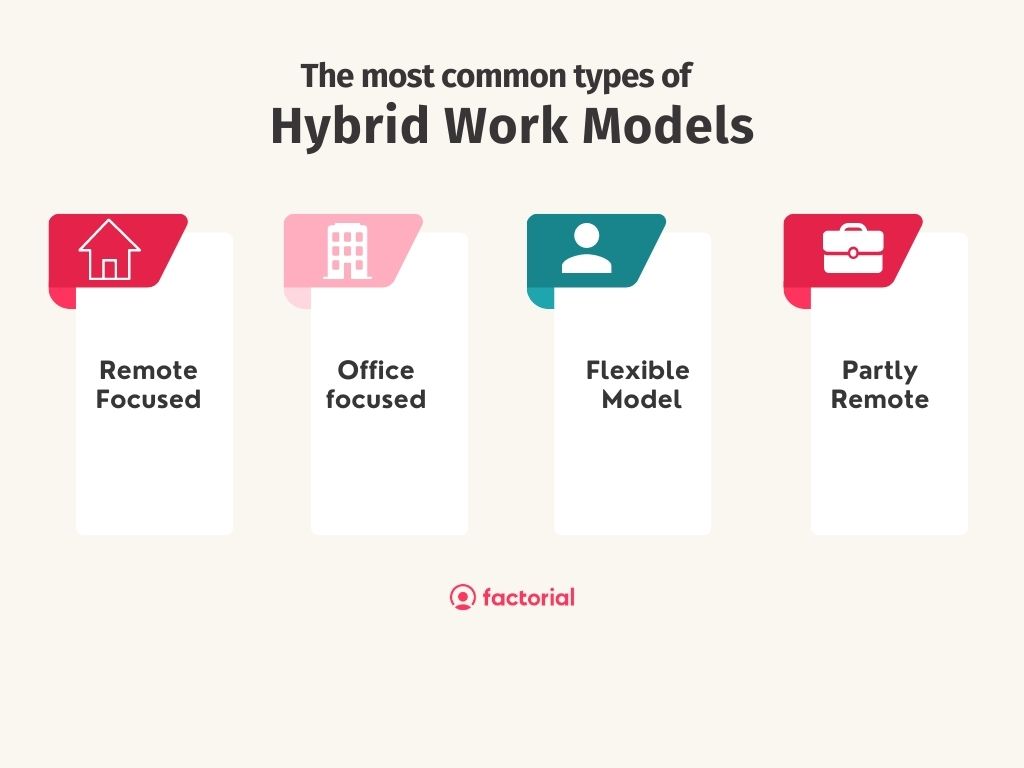The hybrid working model has become a popular working approach for employers all over the world. Due to the drastic changes that were put into place during the pandemic, companies quickly adapted their existing work arrangements to offer a more flexible approach to their employees.
After the pandemic, companies were able to see just how productive their employees were when working from home. And for many companies, remote and hybrid work models became the new norm.
In this article, we will explain what the hybrid working model is, the types of models, the benefits and tips on how you can better manage a hybrid workforce.
What is a Hybrid Working Model?
Hybrid work is a flexible working model which is a combination of in-office and remote working. Sometimes employees have the ability to pick and choose when they would like to work from home and when they would like to work in the office. The thing about the hybrid model is that there isn’t a “one-size-fits-all” approach. Therefore, companies must adjust the model to fit the needs of their company and employees.
Last year, a report by Accenture found that 83% of 9,326 workers surveyed say they prefer a hybrid model — in which they can work remotely at least 25% of the time.
The pandemic proved just how productive employees can be, promoting transparency and most importantly, flexibility. A recent survey conducted by Envoy in April 2022 showed that a whopping 77% of companies have already opted to go hybrid.
What’s more, 56% of those companies are allowing employees to choose when and how often they wish to come into the office. It’s safe to say flexible work is one of the few positive takeaways that workers have gained from the pandemic.
Types of Hybrid Work Models
Remote Focused: In this model, the default is that every employee is able to work remotely. Meetings are conducted online. Only those workers with jobs that cannot be carried out remotely will be required to be on-site.
Office focused: Workers at companies with this model are expected to be on-site, with exceptions determined on an individual or team basis. This model is common where the majority of employees need to deal with customers face-to-face.
Flexible Model: Employees who were able to work remotely during the COVID pandemic choose to continue working from home or go to the office. Occasionally they will need to go into the office for meetings and other events.
Party Remote: In the partly remote hybrid model some teams are fully remote such as the marketing team while other departments such as HR or Sales are office-bound. Companies that use this model need to ensure that they have the right communication strategy.
In this competitive job market, companies must adapt their ways of working to meet the needs of the employee. It’s more than clear that employees want flexible working arrangements. A survey by Wakefield Research shows that almost half of employees (47%) would likely look for another job if their employer doesn’t offer a flexible working model.
👍 Advantages of the Hybrid Working Model:
- Higher productivity levels: A hybrid work schedule offers the right balance of convenience and productivity.
- Better work-life balance: The flexibility of a hybrid working model also benefits employees with caregiving and other outside-of-work responsibilities.
- Happier employees: The autonomy that a hybrid solution offers results in increased job satisfaction.
- Cost-effective: Flexible working means fewer employees are at the office at one time, resulting in savings on office space and utilities.
👎 Disadvantages of the Hybrid Working Model:
- It’s more difficult to collaborate with remote employees: It’s crucial that you determine a communication channel with your employees, otherwise collaborating can become impossible.
- Harder to manage hybrid schedules: For HR or People Managers it can be considerably difficult to manage hybrid schedules, especially if they are a large company.
- Doesn’t work for all sectors or industries: Some teams need to be in-office full time due to the nature of their work.
- Faster employee burnout: Your team may work much longer hours when working from home and take fewer breaks than the on-site folks.
What is the Difference Between Hybrid and Remote Work?
Remote work is also known as working from home (WFH), teleworking, virtual work and more. Regardless of the word you use, the concept is the same. Remote work is essentially working from a location outside of the company office. For example, remote workers will perform all 100% of their job from home rather than in the office.
The hybrid work model consists of teams who work in mixed environments, a combination of the office and remote work. Some of the team may work from home part of the week and the remainder in the office.
How to Choose the Best Model for Your Company
To find a hybrid model that works for your company, survey your employees to find out what they want. By involving employees, you can create a working model that motivates your employees to embrace change and helps them to stay productive.
Surveys are the best way to gauge how your employees feel about hybrid or remote work models. Ask questions about the working model they would prefer and include examples.
Here are some survey questions you could ask your employees:
- Would you choose to work in the office to collaborate with your team?
- How many days per week would you prefer to work from home?
- If you had access to a coworking space close to home, would you prefer to use that instead of commuting to the office?
Once you find out which working model your employees are looking for, you can begin to tailor your hybrid work model accordingly. With a hybrid working model, it’s extremely beneficial to use a desk and meeting room management app.
Time Tracking Benefits for a Hybrid Workforce
One final important thing you need to consider when you implement your hybrid work schedule is how you are going to manage and coordinate it. Are you going to use specific tools and technology to manage shifts?
One option is to use a shift schedule excel spreadsheet to keep things organized. However, this is a basic tool that’s open to confusion and human error. This means it’s not a great solution in the long term.
Another option is to invest in shift management software. This makes it easy to plan recurring shifts on a regular basis, visualise schedules, and run custom reports. You can use tools to assign and alter employee shifts, run reports to see trends and visualise important data. And your employees can easily check up on their upcoming shifts and request changes through an employee portal. All this makes for a much more efficient hybrid working model.
If you are looking for a shift management solution, Factorial may be just what you are looking for. Our shift management software is included with a subscription to Factorial’s comprehensive HR software. Our all-in-one HR solution offers other remote work software features too, such as communication platforms and document management.
While the hybrid working model isn’t a new concept, it’s increasing in popularity. Many tech companies have adopted these working models, either by going fully remote or implementing the hybrid model.



